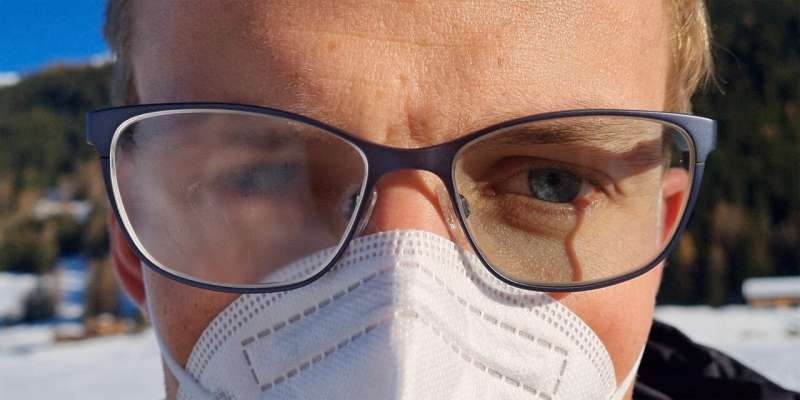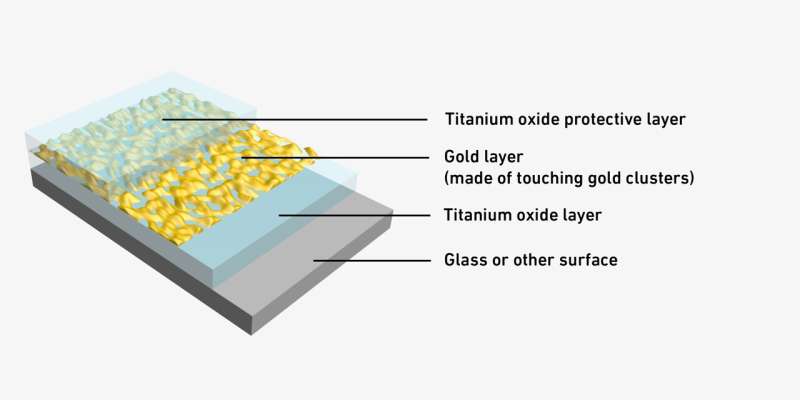Gold-based passive heating for eyewear

Researchers at ETH Zurich have developed an ultrathin, gold-based transparent coating that is able to convert sunlight into heat. It can be applied to glass and other surfaces to prevent them from fogging. Applications for the new coating include eyewear and car windshields.
Researchers in the group led by ETH Professors Dimos Poulikakos and Thomas Schutzius point out that their coating is fabricated with methods that are used extensively in manufacturing. In a cleanroom and using vapor deposition under vacuum, minute amounts of gold are deposited onto the surface. ETH Zurich has applied for a patent on the coating.
Absorbing a large proportion of infrared radiation
What's special about the new coating is that it absorbs solar radiation selectively. Half of the energy contained in sunlight resides in the infrared spectrum, the other half in the visible light and UV radiation spectrum. "Our coating absorbs a large proportion of the infrared radiation, which causes it to heat up—by up to 8 degrees Celsius," explains ETH doctoral student Iwan Hächler, who was a driving force behind the development. It absorbs only a minor fraction of the radiation in the visible range, which is the reason why the coating is transparent.
The new coating takes an approach that differs from conventional antifogging methods. Traditionally, surfaces are coated with water-attracting (hydrophilic) molecules, which results in an even spread of condensation. This is how antifog sprays work. But the new method instead heats the surface, thus preventing humidity-induced condensation from forming there in the first place. It's the same principle as is used for a car's rear window. But, as Hächler points out, electric heating is inefficient and energy wasteful. In contrast, the new coating is heated passively and requires, during daytime, no additional energy source.

Thinner, pliable and more efficient
Poulikakos, Schutzius and their teams have been working on passively heated surface coatings for several years. Three years ago, the scientists published their first research paper on a gold coating that prevented transparent surfaces from fogging up. The coating they have now presented has many benefits over the first: It is made up of a single gold nanolayer and is significantly thinner, which makes it more transparent as well as pliable. Further, it is also more transparent and efficient because it absorbs infrared light more selectively.
Gold might be expensive, but the researchers emphasize that their coating requires so little that the material costs remain low. The coating comprises minuscule, extremely thin clusters of gold sandwiched between two ultrathin layers of titanium oxide, an electrically insulating material. Due to their refractive properties, these two outer layers increase the efficacy of the heating effect. Moreover, the top layer of titanium oxide acts as finish that protects the gold layer from wear. This whole "sandwich" is just 10 nanometers thick. By way of comparison, a common gold leaf is twelve times thicker.
The individual gold clusters touch each other minimally, which is what allows the gold layer to just start conducting electricity. So in the absence of sunlight, it would still be possible to use electricity to heat the coating.
The researchers will now develop the coating further for other applications. In the process, they will investigate whether other metals work just as well as gold. In addition to eyewear and windshields, this antifogging method could be used wherever objects must be both heated and transparent—such as windows, mirrors or optical sensors.
There is no need to fear, however, that this would cause a car or a building to heat up more in the summer. ETH doctoral student Hächler explains, "The pane coating absorbs infrared rays from the sun, which specifically heats the pane and prevents the radiation from reaching the inside of the car or building. As a result, the interior heats up even less than it would without the coating."
The research is published in the journal Nature Nanotechnology.
More information: Gabriel Schnoering, Transparent sunlight-activated antifogging metamaterials, Nature Nanotechnology (2022). DOI: 10.1038/s41565-022-01267-1 , www.nature.com/articles/s41565-022-01267-1
Related Research Briefing: Combating fogging with selective sunlight nano-absorbers. Nature Nanotechnology 2022, DOI: 10.1038/s41565-022-01269-z , www.nature.com/articles/s41565-022-01269-z
Journal information: Nature Nanotechnology
Provided by ETH Zurich





















